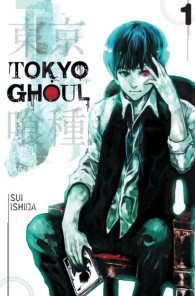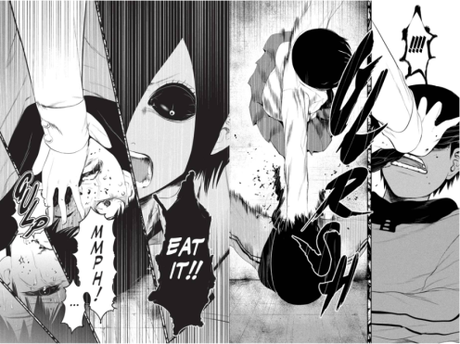 Title: Tokyo Ghoul
Title: Tokyo Ghoul
Genre: Action, Horror, Psychological
Publisher: Shueisha (JP), Viz Media (US)
Artist: Sui Ishida
Serialized in: Weekly Young Jump
Translation: Joe Yamazaki
Original Release Date: March 17, 2015
Review copy provided by publisher.
Sui Ishida’s Tokyo Ghoul is a interesting manga that brings two different beings into a world aware of them and the dangers each present. It’s a shame then that what holds his first volume back from being great and a tone setter for the rest of the series is the artwork and the obsession of trying to joke at the worst times. It doesn’t convey the sense of horror that, with the settings or theme presented, it should, and that’s unfortunate.
Ken Kaneki is a college freshman smitten with a customer he sees at his usual shop Anteiku, mostly because she is hot, but also because she’s reading a book by one of his favorite authors, Sen Takatsuki. When they bump into each other and she sees the book he’s reading, they connect and a romance seems to bloom. However, Ken soon learns when he gets bitten in the shoulder that there was never romance in play, just him getting tricked by a ghoul, considered a hostile species in Tokyo. He manages to survive, but in order for him to live from his injuries, that ghoul’s organs have replaced his. Now Ken has to deal with life as a human and a ghoul.
Expressing what Tokyo Ghoul does well is not hard. It is a compelling look at someone who once was human adapting to being something else. It involves throwing away his values as a human while also threatening to make him come off as evil. His conversation with Touka, a ghoul who works at the cafe, after she feeds him the innards of a dead human, shows a sort of elitism but necessary response to someone who was never in this position before. If the opposite personality appeared – one that was more forgiving to Ken’s woes – it wouldn’t be a very good scene. But Touka has no desire to care for Ken, so putting up with Ken’s words wasn’t going to happen, which means he has to continue to struggle finding his place between being human and a ghoul.

Explaining what doesn’t work in Tokyo Ghoul is not easy. But for me, what continued to bug me was the artwork. In certain scenes when characters are talking and standing around it works. When there’s action going on or when Ken gets stabbed, it falls apart. Its messy and moments of anguish come off as comical. This series is mostly going for atmosphere, but in only reading a volume of Flowers of Evil, I understood what it was going for. Is Tokyo Ghoul going for a light hearted tone or does it really want to induce some sense of peril in its work? I’m interested in finding out since I like the sum of its parts, but I hope it puts those parts together soon.
 Title: Tokyo Ghoul
Title: Tokyo Ghoul
